Falcon Northwest FragBox SLI: Dare to Dream
by Jarred Walton on May 3, 2006 9:00 AM EST- Posted in
- Systems
Features
We've talked about the appearance of the case, and we've talked about prices. There's a reason for the prices, of course, and that's the features, components, and performance that you get with the system. It's no secret that you get greatly diminishing returns on many hardware upgrades. A $1000 system is rarely twice as fast as a $500 system - at least, if you discount the difference in performance between IGP and a discrete graphics card - and $2000 systems are even less of a performance jump from $1000 builds. Doubling or tripling cost to get into the $5000+ range will get you about the fastest system currently available, but many of the components will carry a 10-20% performance increase for twice the cost. So here's a look at the components Falcon includes in one of their top FragBox SLI systems.
Fastest CPU currently on the market? Check. Fastest graphics cards currently on the market? Check - at least somewhat. See, NVIDIA is launching their Quad-SLI platform, and the system as tested "only" comes with two 7900 GTX 512MB cards - BFG overclocked models, no less. If you want Quad-SLI, Falcon can actually work that into the FragBox case as well. Who needs Quad-SLI? To paraphrase Kelt Reeves, it's pretty much only for the filthy rich people running around with 30" Apple Cinema (or Dell 3007FPW) displays; 2560x1600 can actually bring even a mighty 7900 GTX 512 SLI or X1900 XT CrossFire setup to its knees.
What was that about using the FragBox with X1900 CrossFire? As you're likely aware by now, CrossFire and SLI are competing standards, and both companies currently refuse to allow their multi-GPU setup to run on the other's chipsets. ATI has at least worked with Intel to get CF running on 975X, but what we'd really like to see is for both companies to take off the shackles and let people use whatever multi-GPU setup they want on any motherboard with dual X16 PCIe slots. The uATX/SFF market needs help even more, as only recently have we managed to get an SLI uATX board and there are still no CF uATX designs. Given that there are quite a few games where X1900 XT CF comes out ahead of 7900 GTX SLI these days (and of course there are still areas where NVIDIA leads ATI), ideally the decision of what GPUs to run should be up to the customer. We don't need official support for CrossFire on SLI or SLI on CrossFire, but we'd love to see the driver locks removed once and for all. Is it likely to happen? No, but as we said at the start, dreams are free.
Other areas continue to go ultra-high-end as well. The system has two 150GB Raptor drives in RAID 0. If you prefer, you can get a couple 400GB Seagate drives for less money, or you can go for a full terabyte of storage complements of two 500GB Seagate drives for even more money than the Raptors. If you don't want RAID 0, you can also opt out of that feature and simply have one or two drives installed, or you can go with the safer route and have the system configured for RAID 1.
The one area that falls short is the audio. Realtek ALC850 isn't terrible, but it certainly isn't as good as even the original Audigy, let alone many of the other high-end sound cards. We talked with Falcon about that and asked to get a couple 7900 GT cards with an X-Fi sound card to use as an alternate configuration. Sure, you sacrifice some GPU performance, but depending on the monitor and resolution you run, it may or may not matter. The Realtek ALC850 is adequate for most tasks, but even with $55 Logitech speakers there was a clear difference in quality between the integrated audio and the X-Fi card. If you're planning on connecting the FragBox to some really nice speakers or headphones, we would seriously consider upgrading the audio subsystem. (That might mean you have to ditch the FragBox and go for the full Mach V setup if you're looking at FNW systems.)
So the system comes equipped with the best parts money can buy, but there's still the problem of that price sticker, right? How can anyone justify spending thousands of dollars on a computer? FNW charges a pretty hefty price premium for putting your system together, but they really do go all out in building and testing the system. Included with every FNW computer is a binder of documentation, and part of the documentation lists performance and stress testing results. Scores from all three of the latest Futuremark 3DMark applications are listed, so you can always refer back to them to verify whether or not your system continues to run at peak performance. There is also a total of about 3 days of stress testing conducted on the systems, including running Prime95 (one instance per CPU core) for 12 hours and a loop of 3DMark06 for 12 hours. You can be relatively sure that whatever FNW ships out will run fully stable - just remember to "pop the hood" and dust out the fans and heatsinks twice a year to maintain optimal heat dissipation. What it boils down to is that Falcon employs some very knowledgeable technicians, and if you want a really skilled computer person assembling and troubleshooting your system, you're going to pay extra. For some people, it's worth the peace of mind and support that you get.
The rest of the documentation provided with the system is also superb, and echoes my feelings on several points. For example, they suggest installing all of your games into C:\Games rather than into the default directory. This helps to keep your hard drive more organized, as the Program Files folder has simply turned into the new root directory as far as applications are concerned. Let's not even get into the discussion about games that install to C:\Program Files\[Publisher]\[Developer]\[Game Name] -- even when the developers haven't released any other games! I can't say that I really learned anything new from the manual and documentation, but it does have quite a few pointers that many people (and companies) could find useful.
We've talked about the appearance of the case, and we've talked about prices. There's a reason for the prices, of course, and that's the features, components, and performance that you get with the system. It's no secret that you get greatly diminishing returns on many hardware upgrades. A $1000 system is rarely twice as fast as a $500 system - at least, if you discount the difference in performance between IGP and a discrete graphics card - and $2000 systems are even less of a performance jump from $1000 builds. Doubling or tripling cost to get into the $5000+ range will get you about the fastest system currently available, but many of the components will carry a 10-20% performance increase for twice the cost. So here's a look at the components Falcon includes in one of their top FragBox SLI systems.
| Falcon Northwest FragBox SLI | |
| Motherboard: | EVGA 131-K8-NF44-AX NF4 SLI (NVIDIA nForce4 SLI chipset) Micro-ATX |
| Processor: | Socket 939 CPU up through FX-60 |
| Heatsink/Cooling: | Zalman CNPS7000Cu (most 939 HSFs will fit) 1 x 40mm rear fan; 1 x 80mm HDD fan; 1 x 120mm PSU fan |
| RAM: | Four DIMM slots supporting up to 4GB DDR200 through DDR400 |
| Expansion Slots: | 2 x PCIe X16 with X8 data connections (including SLI bridge connector) 1 x PCIe X16 with either X1 or X16 (configured by jumpers) 1 x PCI |
| Expansion Bays: | 2 x 3.5 inch internal bays 1 x 3.5 inch external 1 x 5.25 inch external |
| Audio: | RealTek AC'97 7.1 (ALC850) |
| Power Suply: | SilverStone 600W Modular PSU 1 x 24-pin; 1 x ATX12V; 4 x SATA; 5 x 4-pin Molex; 1 x mini Molex (floppy) 2 x PCIe 6-pin Additional cables can be added if necessary |
| Motherboard Connections: | 1 X FDD 1 X IDE 4 X SATA 3.0Gbps 5 x 3-pin fan headers 24-pin ATX; ATX12X; 1 x Molex |
| Front Ports: | 2 X USB2.0 1 x 6-pin FireWire 2 X 3.5mm Audio (Headphone and Microphone) |
| Rear Ports: | 4 X USB2.0 1 X FireWire (6-pin) 6 X 3.5mm Audio S/PDIF Optical and Coax Out PS/2 Keyboard and Mouse LAN (GbE) 1 X Serial and 1 X Parallel |
| Extras: | 8-inch cold cathode light Acrylic faceplate with logo and light On/Off switch for lights on rear of case Carrying handle on top (removable) Case windows on left and right |
Fastest CPU currently on the market? Check. Fastest graphics cards currently on the market? Check - at least somewhat. See, NVIDIA is launching their Quad-SLI platform, and the system as tested "only" comes with two 7900 GTX 512MB cards - BFG overclocked models, no less. If you want Quad-SLI, Falcon can actually work that into the FragBox case as well. Who needs Quad-SLI? To paraphrase Kelt Reeves, it's pretty much only for the filthy rich people running around with 30" Apple Cinema (or Dell 3007FPW) displays; 2560x1600 can actually bring even a mighty 7900 GTX 512 SLI or X1900 XT CrossFire setup to its knees.
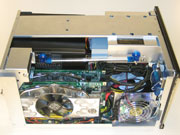 |
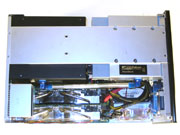 |
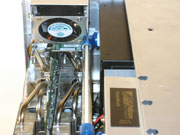 |
| Click to enlarge | ||
What was that about using the FragBox with X1900 CrossFire? As you're likely aware by now, CrossFire and SLI are competing standards, and both companies currently refuse to allow their multi-GPU setup to run on the other's chipsets. ATI has at least worked with Intel to get CF running on 975X, but what we'd really like to see is for both companies to take off the shackles and let people use whatever multi-GPU setup they want on any motherboard with dual X16 PCIe slots. The uATX/SFF market needs help even more, as only recently have we managed to get an SLI uATX board and there are still no CF uATX designs. Given that there are quite a few games where X1900 XT CF comes out ahead of 7900 GTX SLI these days (and of course there are still areas where NVIDIA leads ATI), ideally the decision of what GPUs to run should be up to the customer. We don't need official support for CrossFire on SLI or SLI on CrossFire, but we'd love to see the driver locks removed once and for all. Is it likely to happen? No, but as we said at the start, dreams are free.
Other areas continue to go ultra-high-end as well. The system has two 150GB Raptor drives in RAID 0. If you prefer, you can get a couple 400GB Seagate drives for less money, or you can go for a full terabyte of storage complements of two 500GB Seagate drives for even more money than the Raptors. If you don't want RAID 0, you can also opt out of that feature and simply have one or two drives installed, or you can go with the safer route and have the system configured for RAID 1.
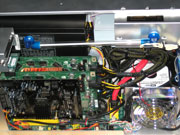 |
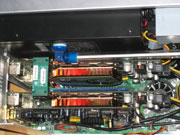 |
| Click to enlarge | |
The one area that falls short is the audio. Realtek ALC850 isn't terrible, but it certainly isn't as good as even the original Audigy, let alone many of the other high-end sound cards. We talked with Falcon about that and asked to get a couple 7900 GT cards with an X-Fi sound card to use as an alternate configuration. Sure, you sacrifice some GPU performance, but depending on the monitor and resolution you run, it may or may not matter. The Realtek ALC850 is adequate for most tasks, but even with $55 Logitech speakers there was a clear difference in quality between the integrated audio and the X-Fi card. If you're planning on connecting the FragBox to some really nice speakers or headphones, we would seriously consider upgrading the audio subsystem. (That might mean you have to ditch the FragBox and go for the full Mach V setup if you're looking at FNW systems.)
So the system comes equipped with the best parts money can buy, but there's still the problem of that price sticker, right? How can anyone justify spending thousands of dollars on a computer? FNW charges a pretty hefty price premium for putting your system together, but they really do go all out in building and testing the system. Included with every FNW computer is a binder of documentation, and part of the documentation lists performance and stress testing results. Scores from all three of the latest Futuremark 3DMark applications are listed, so you can always refer back to them to verify whether or not your system continues to run at peak performance. There is also a total of about 3 days of stress testing conducted on the systems, including running Prime95 (one instance per CPU core) for 12 hours and a loop of 3DMark06 for 12 hours. You can be relatively sure that whatever FNW ships out will run fully stable - just remember to "pop the hood" and dust out the fans and heatsinks twice a year to maintain optimal heat dissipation. What it boils down to is that Falcon employs some very knowledgeable technicians, and if you want a really skilled computer person assembling and troubleshooting your system, you're going to pay extra. For some people, it's worth the peace of mind and support that you get.
The rest of the documentation provided with the system is also superb, and echoes my feelings on several points. For example, they suggest installing all of your games into C:\Games rather than into the default directory. This helps to keep your hard drive more organized, as the Program Files folder has simply turned into the new root directory as far as applications are concerned. Let's not even get into the discussion about games that install to C:\Program Files\[Publisher]\[Developer]\[Game Name] -- even when the developers haven't released any other games! I can't say that I really learned anything new from the manual and documentation, but it does have quite a few pointers that many people (and companies) could find useful.










32 Comments
View All Comments
poohbear - Thursday, May 4, 2006 - link
maybe it's just me, but a big part of my computer hobby is actually putting it together and fine tuning all the components myself. if someone else put it all together for me, it'd ruin the fun portion for me.:/PeteRoy - Thursday, May 4, 2006 - link
Daquing Oilfields is the most graphic and memory intesive map in Battlefield 2, it also has the most vehicles in the game.Next time, make a demo for Battlefield 2 using the daquing oilfields map.
AaronAxvig - Thursday, May 4, 2006 - link
I was under the impression that the harddrives were still a bottleneck at times. Why are 15k SCSI drives never used. Surely two of them and a controller wouldn't put the price over $10,000. And there are a few that would pay that much out there somewhere.2x 147GB 15k Maxtors: $2000
1x Controller Card: $200
And those are rounded up prices.
fatpipes - Thursday, May 4, 2006 - link
15K drives are not very nice for home use. Loud, lots of vibration, shorter lifespan, smaller capacity. A raid array is much nicer for this purpose. 15K drives are almost exclusively SCSI (haven't seen a SATA one yet), which would be essentially impossible for this form-factor and purpose. You would need a board with integrated SCSI, which is not available on any nForce4 boards. Or you would need to drop a video card to free up a PCI slot for a SCSI card.fatpipes - Thursday, May 4, 2006 - link
Basically, you'll be forgoing SLI for SCSI either way (either non-nForce4 with integrated SCSI or nForce4 with a SCSI card). In the tower chassis, this is possible, but still not very sensible compared to SATA RAID.phusg - Thursday, May 4, 2006 - link
Yeah there are a few, and after receiving their PC with 15k HDDs they will realise that the Raptors are silent by comparison and send the box back complaining about the high pitched whine...CrystalBay - Thursday, May 4, 2006 - link
Thanks, that was fun...fatpipes - Wednesday, May 3, 2006 - link
The CPU heat sink fan is _directly_ below the PSU bottom-intake fan. There's just one problem... the CPU fan pulls air DOWN into the fins while the PSU fan pulls air UP into its enclosure. This is worthless for CPU cooling! They'd be better off with a tall passive heat sink.The hard drives could use some shock mounts with a fan bolted directly to the metal frame of the drive cage.
However, their cooling strategy for the GPUs is novel, especially in such a tight space.
Forgive me for being highly critical of SFF PCs, the pressure zones in this case have to be very messy. It looks to me like the airflow moves in a downward spiral starting at the GPU cooler fan and coming out from the back of the power supply after looping over the hard drives and the "front-top" of the motherboard.
However, a warning about placing a positive and a negative fan side-by-side (PSU output, GPU input, 1" apart), they can actually recycle each others' air lowering the efficiency of the fan. You can even see this if you have a single high-speed fan, it actually recycles some of its own air if it isn't enclosed for at least an inch to each side of the opening.
High performance computers don't belong in a box that small.
JarredWalton - Wednesday, May 3, 2006 - link
I did notice the layout issue with the CPU/PSU fans opposing each other. It certainly looks less efficient than having both fans moving air in the same direction. One option is to reverse the direction of the CPU fan, which shouldn't be too hard for FNW to accomplish. Why didn't they do that? Probably because they don't need to.The bottom line is that the system ran stable through all sorts of testing over several weeks of use. Ambient temperatures in my house ranged from 60 F to 80 F depending on time of day, and I was constantly running all sorts of benchmarks and stress tests. No system crashes or BSODs occurred, and the worst thing that happened was a few game "illegal operations". Those pretty much always happen at some point or another during normal use - one of those "Windows is like that" things. A few games exiting once or twice over weeks of use doesn't worry me - it happens on my own PCs as well, and is more likely to be caused by software bugs than anything else. (I had similar periodic application crashes on the DFI system as well, in case you were wondering. There was no pattern or repeatability to them.)
There are about five potential "hot spots" inside high-end comptuers. GPU(s) are the major one these days, followed by CPU, HDD(s), RAM, and chipset(s). Of all the hotspots, the only one I'm really concerned about long-term with the FragBox is the HDD cage. I've had a couple HDDs die on me after a year or so due to heat, and making a "hard drive sandwich" is always a bit of a risk. The cables above the HDDs also limit air flow for the area. However, I can say that the 150GB Raptors do run quieter and cooler than the 74GB Raptors, so hopefully no one has issues. (Short of stress-testing dozens of systems for a couple years, though, there's not an easy way to find out whether or not the system really works well in every possible way.)
"High performance computers don't belong in a box that small"? I disagree. High performance should be available anywhere people want it, and there's definitely a market for SFF computers. There are also laptops that have an even smaller volume than the FragBox and yet they pack in FX-60 chips and dual video cards. The market dictates what products get created, and while the FragBox certainly targets a niche market, it still fills a "need" that some people have.
Pirks - Wednesday, May 3, 2006 - link
All this quad-sli stuff is good, and definitely has its market. However, after reading so many reviews of Voodoo, Alienware and such, I still have one unanswered question - is there at least ONE PC builder/vendor that creates monolithic Apple-like software/hardware combo with full integrated support and such?Let me explain. When you get a mac you get a box which has one central manufacturer and software supplier, and they are also your central source of updates. The deal is: get the box, plug it in and forget the rest. The box will updfate itself, ALL THE HARDWARE DRIVERS/FIRMWARE, all the software, everything. Mac users in general never ever go out and search a driver or something. They got the box, the box works, zero administration and trouble.
Now look at windows. They have online updates, right, but what about drivers, bios and such? What puzzles me here is that there's nothing preventing anyone to become an Apple clone. All you have to do is just prebuild your PCs, ship them with a custom WinXP with all updates integrated and provide one central site where the system quietly goes and downloads all the updates/drivers/bios/software patches/etc, and user NEVER EVER goes to search a driver or a patch or something.
There's even more - such a PC OEM could also do the work of finding reasonably good hardware and sell it to its customers. Wanna get a nice slick video which runs Doom 3 the best? There you go, here's the OEM site, click a button, choose a card rated by game FPS (for example), pay with your CC or PayPal, get the card next day, plug it in, XP goes to OEM site, gets drivers, lock, stock, done! The only thing you do is 1) choose the card 2) pay 3) plug it in 4) and reboot XP when it gets the drivers from OEM. AND NOTHING ELSE!
Well, there could also be a custom XP DVD or something. Say your XP is dead for some reason. You say ah what the hell, pop a DVD, it boots, you say - gimme OS back, it installs over just like Mac OS X (preserving all your old settings/software), or in some similar fashion, doesn't ask you questions (!) and that's it.
OEM could mail out those OS DVDs on request, or whatever... let ppl download them for a small fee.
I mean, this is a golden opportunity people! I've been beaten in Mac forums like hell, they all say the same - go prick yourself with your drivers/bios/chinese hardware and virii/worms. WE SMART MAC FOLKS HAVE OUR FIRE'N'FORGET BOXES which you stupid Windoze moron will NEVER GET because Windoze is a legacy ancient OS that _STINKS_, your custom PC is a pile of chinese bullpuke and blah blah blah...
I mean, not taking into account a crowd of crazy people in those forums (some of them DO require a help of specialist) they say very reasonable thing. PC is excellent for enthusiast, Mac will suck forever at that. But for the stupid Joe, for the guy who doesn't know where the floppy slot is - why there are no PC OEMs who provide anything that at least distantly resembles this special "fire and forget" experience of Macs?
There are many OEMs like Voodoo and FNW who specialize in ultra fast machines. The question is - is there at least ONE PC builder that specializes in ULTRA-CONVENIENT and ZERO-ADMINISTRATION machines, similar to Macs? If there is none, then WHY???
Gimme some fresh thoughts on that, I need nice good rest from those Mac forums. Maybe they right, PC is really $h1t, but there must be some serious reason why PC OEMs can't or don't want to provide similar "everything in one fire'n'forget box" experience like Apple provides. If I got some bags of gold in my vault, I'd established my own cmpany right away. If noone has this feature of providing "Mac-like" friendly and easy to setup/use PCs, I could become the next Dell! Just need some startup capital first, hehe :)